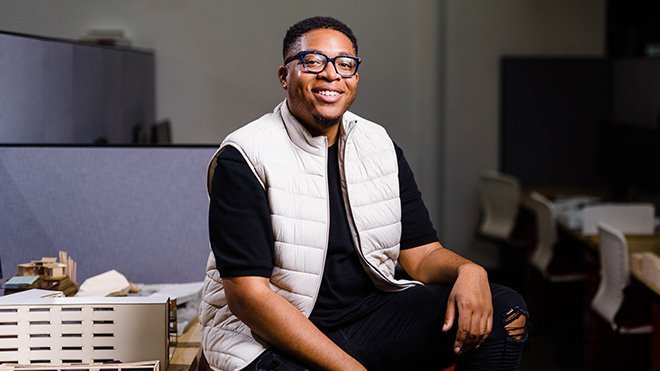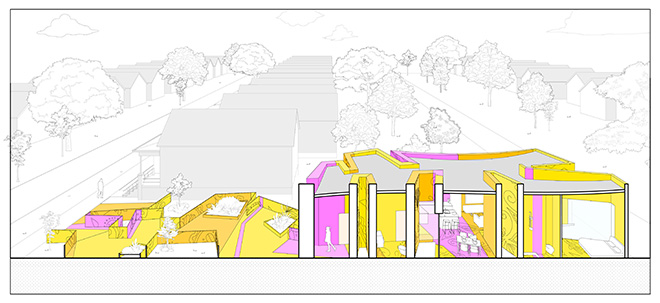At the Forefront of the Black Architectural Movement
Robert Clarke ’14 M’16 shares his thoughts on creating a Black architectural style, his design inspirations, and why he chose to study at RWU.

“Art can begin with an eye for detail, seeing the magnificent in the mundane,” says Robert Clarke ’14 M’16. Marrying a Black aesthetic with modern tools to create experiences that celebrate and champion Black life and culture, Clarke’s design approach is evolving ideas about architecture’s future.
Clarke received his Bachelor and Master of Architecture at RWU and has worked at international firms, from Terreform ONE in New York City, to Gensler Architects in Texas and Los Angeles, and Archi-Union Architects in Shanghai, China. In 2020, the Brooklyn resident founded R A L X, a boutique firm that explores and critiques architecture and design discourse. He is also a Design for Spatial Justice Fellow and Visiting Professor at the University of Oregon’s School of Architecture and Environment, where he investigates how to produce an architectural aesthetic that reflects Black American culture, ideas, and traditions.
In the following Q&A, Clarke shares his thoughts on creating a Black architectural style, his design inspirations, and why he chose to study at RWU.
Q: What’s appealing about architecture?
Clarke: Architecture is about relationships, the relationships between an environment, an object being fitted into it, and the people who interact with both. My father helped me to learn to see how things fit together. My mom helped me learn to use my hands to shape ideas on paper. Architecture, the tools and techniques used to build bridges between ideas and action, asks the architect to use all these things. I like that.
Q: How does your work act as a lens through which to observe and comment on Black life?
Clarke: Historically, global cultures have designed things and places that reflect their customs and traditions. This hasn’t happened in architecture for African Americans. There is no recognizable Black architectural style. I want my work to correct this cultural and artistic omission by investigating how to build Black culture into architectural forms and motifs.
Q: Can architecture be a tool for social change?
Clarke: While there isn’t a singular Black identity, there are Black American cultural traditions that make up a family of Black identities. This is a valuable lens through which to inform design and, perhaps, some perceptions of the Black aesthetic (which isn’t a monolith). I think it’s possible to develop a Black American aesthetic agenda in architecture, to give meaning to a set of experiences and have them infused into a unique and valuable kind of architectural movement.

Q: Is there an architect with whose work you most closely identify?
Clarke: David Adjaye is a British architect (and a knight!) who helped design the National Museum of African American History and Culture in Washington, D.C. Diébédo Francis Kéré is a Pritzker Prize-winner, the first Black architect to win. They’ve both incorporated cultural and historical touchstones into their work while also considering social justice as a lens through which to sift design ideas. Additionally, architects Germane Barnes and Olaekan Jeyifous both search for a future and identity in their work that is intrinsically connected to blackness.
Q: How have your studies shaped your aesthetic?
Clarke: My study and practice feature computational design and the way complex forms can inform new ideas that are directly connected to Black identity. When I led Gensler Architects’ Computational Design group, it offered me an opportunity to investigate digital tools and explore the concepts I began studying at Roger Williams University. My studies and my experiences pushed me to expand my ideas of what was possible. Engaging with other Black architects and theorists revealed what was possible when investigating Black identity in architecture, its complexities, and challenges.
Q: Is there a style of design that informs your work?
Clarke: My study and practice feature computational design and the way complex forms can inform new ideas that are directly connected to Black identity. While my undergraduate studies focused largely on modernism and the work of folks like Ludwig Mies van der Rohe, my graduate study looked toward computational design heroes like Zaha Hadid and Greg Lynn. My time spent in places like Shanghai helped challenge me intellectually and professionally while also pushing me to attempt work that merged the worlds of architecture and African American culture. I learned the rules, and then learned to hack the rules.
Q: How did you develop the pedagogical lens through which you shape and deliver your lectures?
Clarke: When I was starting to pursue ideas about architecture and blackness as an intellectual project, I was working with my dad during the day and working on architecture competition submissions at night. That work ethic has found its way into my thinking about how we teach architecture. There aren’t neat dividing lines between ourselves and the spaces we inhabit. Education is both external (what are others doing that might provide ideas and inform our work) and internal (how am I thinking about this thing or challenge).
Q: Why did you choose Roger Williams University for your studies?
Clarke: My best friend was accepted to a culinary school in Rhode Island, and I thought it would be nice to start this journey with family. I attended a Roger Williams University orientation and met cool people who helped ensure my experience was both personal and enjoyable. After that, I knew I’d found the university that was the right mix of people and places that would aid in my personal and academic growth.
Q: Why should people study architecture?
Clarke: Architecture is both a practical and a philosophical pursuit. It’s about narratives, about the ability to share stories in the design and production of objects like buildings. It can feature cultural identities. It can help test ideas. These are useful not only in architecture, but in life.
Q: Is there a message you want to share with aspiring architects?
Clarke: Have a viewpoint. Then, support your viewpoint with narratives designed to appeal to your audiences’ hearts and minds.